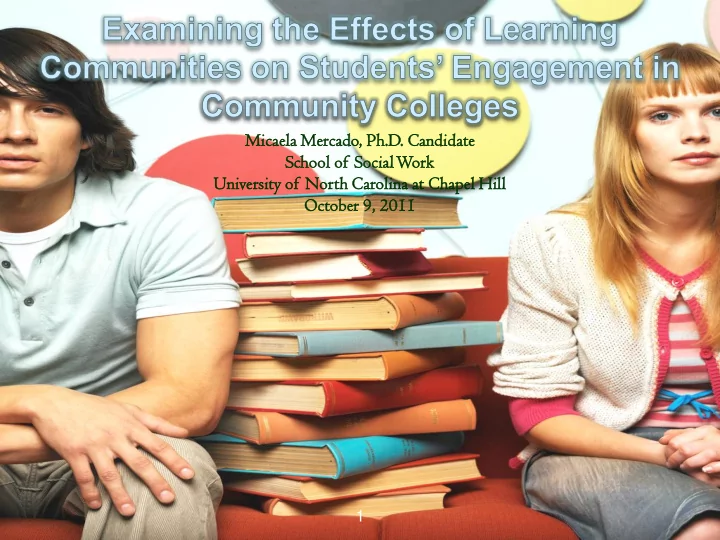

Micael ela a Mercado ado, , Ph.D. Candidate date School of Social Work Univers rsity ity of North Carolin ina a at Chapel Hill October er 9, 2011 1
Examining the Effects of Learning Communities on Students’ Engagement in Community Colleges Micaela Mercado, Ph.D. Candidate School of Social Work University of North Carolina at Chapel Hill Contact email: mmphd@unc.edu 18 th National Conference on Students in Transition, St. Louis, MO October 9, 2011 2
Introduction Theory Methods Results Implications 3
Compared to 4- year institutions… 4
Parental education level by race/ethnicity, 2003-04 (n=7,900) SOURCE: U.S. Department of Education, National Center for Education Statistics, 2003-04 Beginning Postsecondary Students Longitudinal Study, First Follow-up (BPS:04/06). 5
3-years 6-years 6
Percent Change In Employment, by education 2008-2018 (projected) 7
The Community College Environment: Factors conducive to promoting student engagement, persistence, and degree attainment Challenge Educational Institution Supports At-risk students Informal and formal Assistance navigating the lack academic &/or environmental structures: system, information, resources, social preparedness Programs, services, courses, guidance, opportunities study groups, professional organizations, learning communities, study skill courses, mentoring 8
academic courses integrated within assumption that students who a social environment designed to participate build relationships promote learning and engage with faculty & peers are more students in class/college likely to succeed in college 9
Research Questions 1. Which students participated in LCs? 2. What was the impact of LCs on active-collaborative learning? Student- faculty interactions? And, students’ academic performances? 3. Did the impact of LCs vary by minority and first-generation status? 10
Data Source: Community College Survey of Student Engagement Intervention Sample Completed Plan to Enroll Learning Community 35,761 12,816 (36%) 22,945 (64%) Completed Learning Community: Variable Frequency (%) Variable Frequency (%) Started here 9,435 (74%) Female 8,248 (64%) Full-time 10,441 (82%) Race: White 8,301 (65%) Degree goal: Black 1,645 (13%) Certificate 1,034 (8%) Hispanic 1,512 (12%) AA 5,449 (43%) Traditional 8,601 (67%) Both 3,411 (27%) First-generation College 3,375 (33%) Work: 20 hrs < LT 7,467 (59%) HS diploma/GED 9,893(77%) Dependents: 1+hrs 7,645 (60%) 11
Analytical Model Intervention Outcome Independent Variables (Treatment) Pre-College Characteristics: • Gender • Race Behavior: Engagement • Age Active-collaborative learning Learning community • Generational status Student-faculty interactions • Marital status Academic performance • Academic credential • College status • Enrollment status • Degree goal • Work hours • Income Persistence • Dependents Degree attainment College Experience • Perceived college support • Social service participation • Peer relations • Instructor relations • Administrative relations • Intervention control 12
Dependent Variables Active-Collaborative Learning scale Student-Faculty Interactions scale Asked questions in class or contributed to Used email to communicate with an class discussions instructor Made a class presentation Discussed grades or assignments with an instructor Worked with other students on projects Talked about career plans with an instructor during class or advisor Worked with classmates outside of class to Discussed ideas from your readings or prepare class assignments classes with instructors outside of class Tutored or taught other students (paid or Worked with instructors on activities other voluntary) than coursework Participated in a community-based project as a part of a regular course Discussed ideas from your readings or classes with others outside of class (students, family members, co-workers, etc.) Scale: 0=Never 1=Sometimes 2=Often 3=Very often 13
Propensity Score Weighting Neyman-Rubin counterfactual framework • observed outcome • unobserved outcome Y i = W i Y 1i + (1 – W i ) Y 0i Y 0i , Y 1i two potential outcomes; W i =1 denotes receipt of treatment, W i =0 denotes no receipt of treatment; and Y i is the measured outcome variable. Estimates of counterfactual are examined by: E(Y 0 |W=0) comprises the mean outcome of the nontreatment group; & E(Y 1 |W=1) comprises the mean outcome of the treatment group. τ= E(Y 1 |W=1) – E(Y 0 |W=0). 14
15
RQ1: Which students participate in LCs? Logistic regression predicting participation in LCs (n= 35,761) Variable Log Odds S.E. Gender: Men 0.77*** 0.02 Race: White African American 0.57*** 0.02 Hispanic 0.65*** 0.03 Other 0.82*** 0.04 Age: Traditional age student 0.97 0.03 First-generation status 0.85*** 0.02 Academic credential 1.65*** 0.06 Started at college 1.01 0.03 Enrollment: Full-time 1.54*** 0.05 p<.05; * p<.01; *** p<.001*** 16
RQ1: Which students participate in LCs? Lower odds of participating in LCs • Men • African American students • Hispanic students • First-generation college students Higher odds of participating in LCs • Students with a certificate or college degree • Full-time students 17
RQ 2 & 3: The Effect of LCs on Outcomes Active- Academic Student-Faculty Collaborative performance Interactions Learning (College GPA) Avg. 0.83 (.11)*** 0.31 (.09)*** 0.04 ( .02) Treatment Effect LC*Gender -0.26 (.09)** LC*African American 0.28 (.12)* LC*Enrollment 0.38(.09)*** 0.25(.11)* 0.05(.02)* *Hispanic and First-generation status 18
• Clustering • Unobservables • Covariate structure • Implementation • CC population • Methodology • Institutional/formal programs • Treatment effects 19
Implications for Practice Implications Identify and strengthen key programmatic features of LCs to better promote active-collaborative learning, student-faculty interactions, and academic performance Assess students’ academic and social progress over time Build mechanisms within curricula to promote meaningful learning activities, collaborative learning between students, and student-faculty interactions Assist Men, First-Generation, Hispanic and African American students actualize their educational objectives 20
Implications for Policy Study Implications Create opportunities for academic success Not all CCs offer LCs Complement LCs with academic and social LCs effectiveness services that target engagement, and academic performance Sustain efforts that increase students Long-term effects of LCs academic and social involvement at the institution (i.e., data-driven systems ) 21
22
Recommend
More recommend